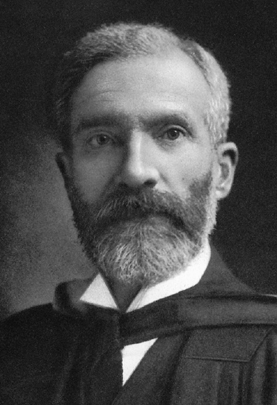Archibald Macallum facts for kids
Quick facts for kids
Archibald Macallum
FRS FRSC
|
|
|---|---|
 |
|
| Born |
Archibald Byron Macallum
April 7, 1858 Belmont, Canada West
|
| Died | April 5, 1934 (aged 75) London, Ontario, Canada
|
| Nationality | Canadian |
| Awards | Flavelle Medal (1930) |
Archibald Byron Macallum FRS FRSC (born April 7, 1858 – died April 5, 1934) was a famous Canadian scientist. He was a biochemist, which means he studied the chemistry of living things. Macallum helped start the National Research Council of Canada, an important group that supports science in Canada. He also played a big role in making the University of Toronto's medical school much better. His main scientific work was looking at tiny particles called ions in cells and blood.
Contents
Early Life and Education
Archibald Macallum was born in Belmont, Ontario, which was then called Canada West. He was one of twelve children. His father was an immigrant from Scotland. At home, Archibald spoke Scottish Gaelic, but he learned English at school.
He went to high school in London, Ontario. After graduating, he became a teacher. He saved money for several years so he could go to university.
University Studies
Macallum then went to the University of Toronto. There, he was inspired by his biology professor, Ramsay Wright. When he was 22, Macallum earned a Bachelor of Arts (B.A.) degree. He also won a special medal for his work in natural science.
For the next few years, he taught high school in Cornwall, Ontario. He also kept doing scientific work with Professor Wright. In 1883, he became a lecturer in biology at the University of Toronto. He also started studying to become a doctor. He learned from Professor Wright and from H. Newell Martin at Johns Hopkins University.
In 1888, he earned his Ph.D. from Johns Hopkins. Two years later, he finished his medical degree from the University of Toronto. After that, he became the very first head of the physiology department at the University of Toronto. Physiology is the study of how living things work.
Changing Medical Education
When Macallum first became the head of physiology, he and other scientists wanted to change how doctors were taught. They believed medical education should be based more on science. By 1908, they had mostly succeeded. That year, Macallum became the head of a brand new department: Biochemistry.
In 1917, he left the university to help create the National Research Council of Canada. This council helps organize and support scientific research across Canada. In 1920, he returned to teaching. He became the head of the new Biochemistry Department at McGill University. He stayed there until he retired in 1928.
Scientific Discoveries
Most of Macallum's scientific work involved measuring very small amounts of salts and ions in liquids inside living things. Ions are tiny particles with an electric charge.
Studying Cells and Blood
In 1901, he discovered that the chromatin inside the nucleus of cells contains iron. The nucleus is like the control center of a cell. In his early years at the University of Toronto, he found ways to measure different ions, like chloride, potassium, and phosphate, in tissues and cell samples.
Using these methods, he learned that some chemicals are found only in certain parts of a cell. For example, some might be in the cytoplasm (the jelly-like substance filling the cell) but not in the nucleus. Because of this important work, he was chosen to be a member of the Royal Society in 1906.
Connecting Life to the Ocean
Macallum's later research focused on the ions found in blood and other body fluids. He made a fascinating discovery: in many animals, the amounts of sodium, potassium, calcium, and magnesium ions in their blood are very similar to the amounts found in seawater.
This finding strongly suggested that animals that live on land originally came from the ocean. Macallum believed that the total amount of ions in vertebrate blood, which is about one-third of what's in seawater, meant that vertebrates left the sea a very long time ago, perhaps during the Silurian period. At that time, the ocean's ion concentration was much lower.
Macallum's experiments and ideas became a key part of a field called biochemical evolution. This field tries to use chemistry to understand how living things have changed over time.
Training New Scientists
Archibald Macallum also taught many future biochemists at the University of Toronto. Some of his notable students included F. H. Scott (the university's first PhD student), Maud Menten, Clara Benson, and James Collip.

